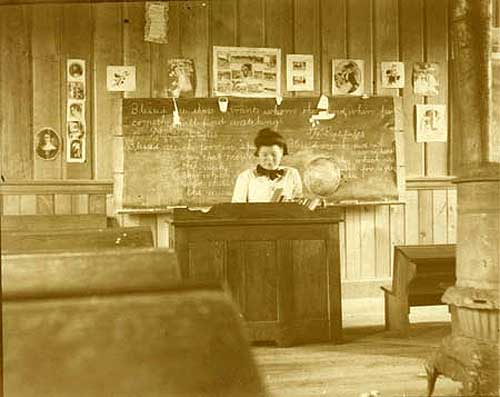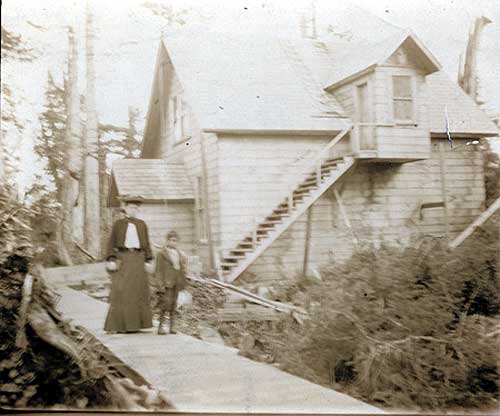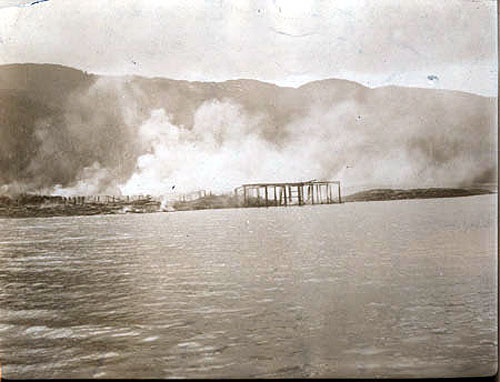 The Village of Port Gravina By DAVE KIFFER February 04, 2006
In 1892, someone did. In the last decade of the 19th Century there was a small village that was as large or possibly larger than the nascent village of Ketchikan. But like many settlements in Southeast Alaska, its life was short. The village of Port Gravina was located near what is now the north end of the Ketchikan International Airport runway. It was founded in 1892 by a group of Tsimpsians from Metlakatla who had attended the Sitka Industrial Training School.  Frank Payne of 10 Twin Lakes Drive, Fairfield Ohio sent these photographs to the Wrangell Chamber of Commerce. They belonged to his late mother Mrs. Ina Walton, who was at the age of 19 taught school in this area Donor: Frank Payne, Courtesy Tongass Historical Society
"The company constructed a sawmill with a wharf that unfortunately went dry at low tide," Roppel wrote in 1995's "An Historical Guide to Revillagigedo and Gravina Islands." "Powered by steam, the sawmill had a daily capacity of 15,000 board feet of sawed and planed timber." Initially, the sawmill produced box shooks for salmon boxes for the canned salmon industry which was also just getting started, but soon the area construction boom found the mill primarily supplying lumber for buildings in Ketchikan and Saxman. Local historian June Allen reports that most of the lumber from the original Stedman Hotel on the corner of Dock and Front streets came from Port Gravina. The sawmill was also instrumental in providing lumber for mining and other operations in the Charcoal Point area north of Ketchikan, just across Narrows from Port Gravina. When the village of Port Gravina was started in 1892, Ketchikan's estimated population was under 100 people, which was what the Federal Government estimated Port Gravina's population at in 1895. But Ketchikan soon began to grow, with the help of Port Gravina lumber. By the time it incorporated into a city in 1900, Ketchikan's population was estimated at nearly 1,000 people. In addition to the sawmill, the Port Gravina mill company operated a general store and built a board walk "street" that connected the most of the houses with the sawmill and wharf. An 1895 photograph by B.A. Haldane shows at least a dozen houses located north of the mill. A significant number of other houses were located along a path south of the mill. Federal officials estimated the 1900 Port Gravina population at just under 100 people. In the early years, the residents asked the federal government to establish a post office at Port Gravina but it was never done. A school - however - was built. According to Roppel, it started in fall of 1899 with Alice B. Hamblett as the first teacher. She was followed by Bertha Hunt, the daughter of pioneer Ketchikan photographer Harriet Hunt. The teacher in 1903 was Olga Hilton, according to Roppel. In her book Roppel quoted a government report that Hilton had written which talked about classes in the school. "Other subjects were introduced besides reading, spelling and other work," the report stated. "There were classes in geography, history, temperance, hygiene and all had instruction in English."  Frank Payne of 10 Twin Lakes Drive, Fairfield Ohio sent these photographs to the Wrangell Chamber of Commerce. They belonged to his late mother Mrs. Ina Walton, who was at the age of 19 taught school in this area. He asked that they be forwarded to interested persons. The Photographs are of Gravina Island. Photo courtesy Ketchikan Museums
"It had only three rooms: Kitchen-dining room across the back and sitting room and bedroom in front, with a porch extending across the front and was furnished except for bedding," Hunt wrote. The community also had a church, according to Roppel, which was completed in 1898. "One of the finest of its kind," Hilton noted in her 1903 report. "It had four colored windows, a beautiful pulpit, plain but nice seats, two large chandeliers, a good carpet, a stove. organ, a bell on the belfry, etc. We hold services here regularly and also a Sabbath School." In an attempt to diversify, the sawmill began to expand into boat building operations, according to notice in the March 7, 1903 Ketchikan Mining Journal. "Hamilton, Simpson and Co are building a 30-foot launch which will be supplied with a 12-horse power gasolene (sic) engine," the Mining Journal reported. "It is intended solely for use in connection with their sawmill business at Port Gravina." But the sawmill obviously had bigger plans according to an advertisement in the May 25th Mining Journal. "Davis and Ridley, designers and builders of steam, sail yacht and tug hulls," read the ad. "Tug's reconstructed, recalked, etc. We also carry a line of high grade pleasure and hunting craft. Be sure to call and see us for boats. Prices reasonable. We are the only reliable and practical boat builders on the Narrows. Yard at Port Gravina Saw Mill." Unfortunately, the boat business never took off and a year later, Port Gravina was no more.  Photo courtesty Ketchikan Museums
The fire spread quickly. In a couple of hours it had wiped out the sawmill, the store and more than half the houses in Port Gravina. "Like most other small Alaskan sawmills, the Port Gravina mill had encountered financial difficulties, and so the company did not rebuild the mill," Roppel wrote in 1995. "Some of the Tsimpsians moved to Metlakatla, others to Ketchikan. Peter Simpson moved to Sitka where he became a leading boat builder." After the residents disbursed, at least two people (John Englebrandt in 1912 and E. L. Scrincsher in 1914) filed for homesteads on Port Gravina parcels, according to Roppel. They and some other residents lived in the remaining houses for several years. By the mid 1950s, there was little trace of the old village and in the early 1970s, when surveyors were working on the airport project, they found several pieces of rusting metal, including one of the old saws, on the former mill site.
Contact Dave at dave@sitnews.us Dave Kiffer ©2005
|